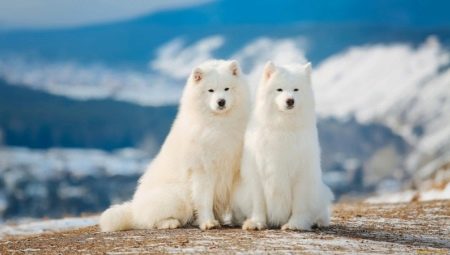The spectacular appearance and friendly nature of Samoyed huskies (or, as they are also called, Samoyeds or Arctic Spitz) are capable of touching and touching absolutely any person. Even at the dawn of the appearance of the breed, Samoyeds were used mainly as sledding and hunting dogs, capable of traveling long distances in harsh climates. To our days, Samoyed huskies are increasingly being raised as companion dogs who can brighten up the leisure time of their owner and members of his family.
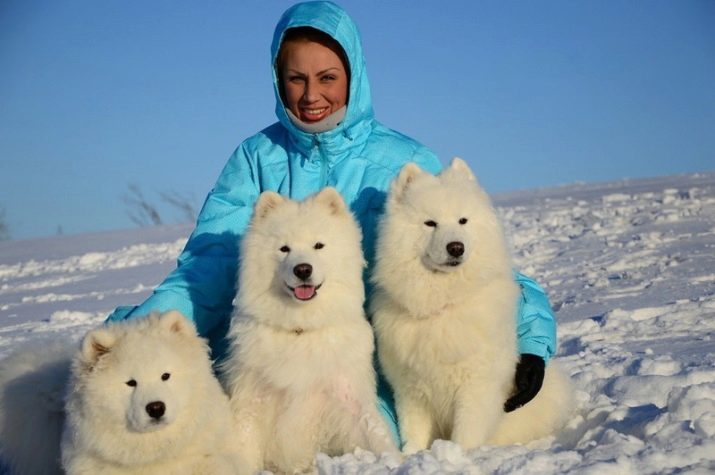
Description
This breed is considered one of the oldest, since the history of its origin dates back to the 11th century BC. The birthplace of the breed is considered the north of Russia (Siberia).
Initially, dogs of this breed were bred by small northern tribes (Samoyeds)who were the ancestors of modern Nenets, Selkups, Enets, Nganasans. Since all the representatives of these tribes contained dogs of the same type, researchers had the assumption that at a certain time Samoyeds managed to domesticate the white wolf. Indigenous people of the North used these dogs as hunting dogs, less often sled dogs. In addition, they were used by Samoyeds as shepherd dogs to help reindeer herders, and even as nanny dogs.
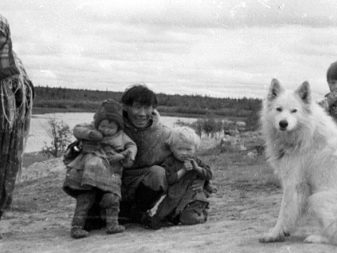

The friendly disposition of Samoyeds to this day allows them to get along well and find a common language with the smallest members of the family.
Samoyed huskies were helped to survive the severe polar nights for representatives of nomadic tribes. For this purpose, with the onset of darkness, the dogs were driven into the dwellings where they slept, hugging them.
Curious versions explaining the origin of the name of this breed. It is generally accepted that it dates back to the collective name of the northern tribes - Samoyeds (another name is Samoyeds). According to another version, not officially confirmed, but with a completely logical justification, the name of the breed is due to the fact that when these dogs were harnessed to the sled, the animals merged with a snowy road. In the dark, it seemed that the sled was moving on its own, which is why they began to call them Samoyeds (that is, from the phrase "they ride themselves"). Later this name was fixed to the breed.

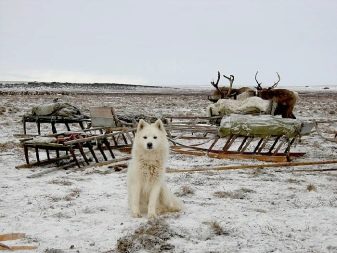
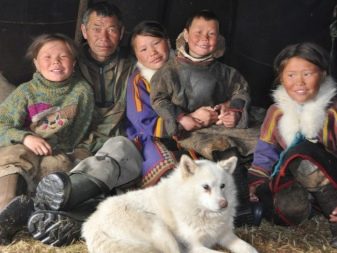
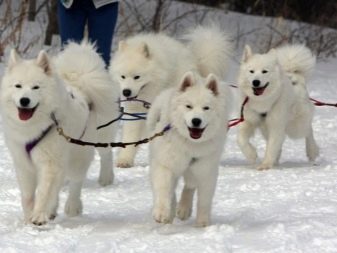
Characteristics and features of the breed
Samoyeds, which are also called Samoyed spitz, are medium in size. The height at the withers can range from 50 to 60 centimeters (depending on the gender and individual characteristics of the animal). Weight indicators range from 15 to 30 kilograms.
The appearance of dogs of this breed makes a strong impression. Samoyeds literally radiate confidence, power, strength, charm and nobility. Dog handlers and professional breeders of Samoyed Spitz argue that the owner of such a dog will never go unnoticed by others.
The muzzle of the Samoyed is very expressive. The slightly slanting eyes and the corners of the mouth rising upward give the impression that the animal is smiling.
These dogs have a large and powerful head, proportional to the body. The triangular ears are widely spaced, slightly rounded at the tips. The ears of the Samoyeds should be erect and symmetrical.
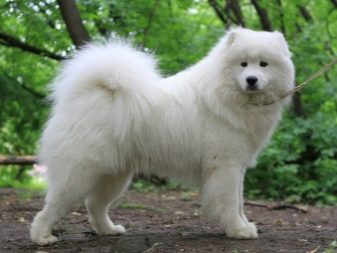
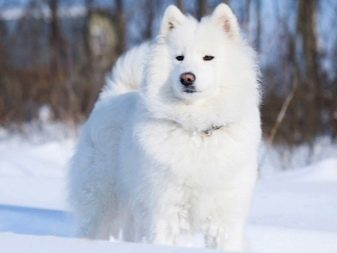

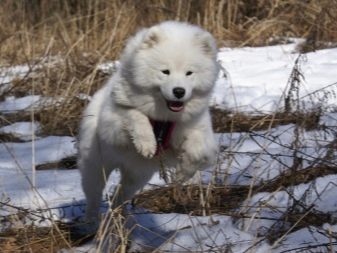
The muzzle of Samoyed huskies is neat, slightly tapering to the nose. Scissor bite, lips tightly closed, black. The nose should be black, but in some cases (for example, in spring or winter) hypopigmentation is permissible, in which brown-pink spots form on the lobe. However, even with discoloration of the lobe, its edging should remain black.
The eyes of the Samoyeds are dark brown, small, with a dark brown fringing. Heterochromia and blue eye color are usually classified as serious, critical flaws.
The neck of the Samoyed huskies is powerful and strong, with a slight bend. The body is compact, slightly longer than the height of the animal at the withers. The back is moderately elongated, has a clearly defined withers and a strong strong lower back. The Samoyed’s body is muscular and strong, well-built.
Both the hind and front legs of the Samoyed huskies are strong and even, with pronounced and well-developed muscles. Fingers are not tightly closed.
The tail is high enough. When the dog is excited, his tail can take the form of a half ring, sinking on his back or sideways.
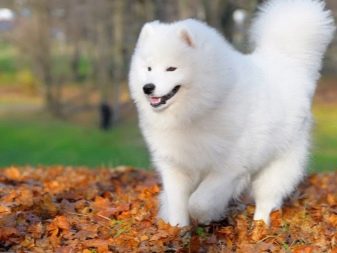
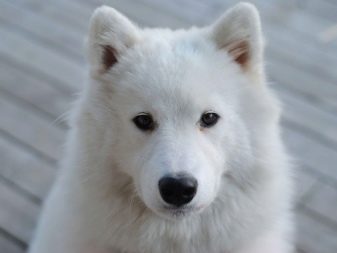

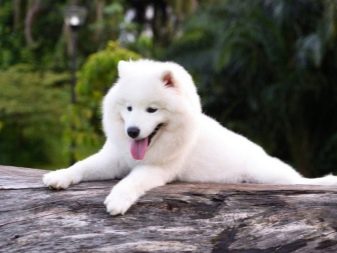
The coat is very thick, dense and radiant. The coat is formed from a short undercoat and long outer hair.
A unique feature of Samoyed wool is the ability to self-clean. Thanks to her, dogs of this breed do not need frequent bathing.
The breed standard provides for snow-white or cream coat color. Also acceptable is a white color with a few areas of biscuit tint. A defect is the light brown color of the coat.
Samoyeds do not have any colors other than those provided for by the breed standard. Many inexperienced dog breeders often take a separate variety of northern Spitz - Swedish lapphounds for Samoyed black huskies. Both physique and habits, both of these breeds are very similar. However, the color in dogs of these breeds is different: snow-white in Samoyeds, black in Lapphounds.
The average life expectancy of Samoyed huskies varies from 12 to 15 years. As practical observations show, Samoyed males live longer than bitches. So, the life expectancy of males is about 14-15 years, bitches - 13-14 years. With proper care and compliance with all recommendations on maintenance, the dog's life expectancy can reach 17-20 years.
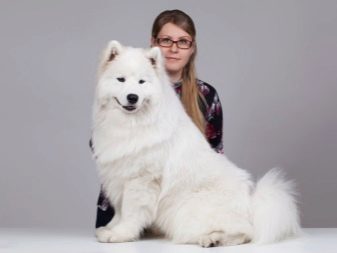
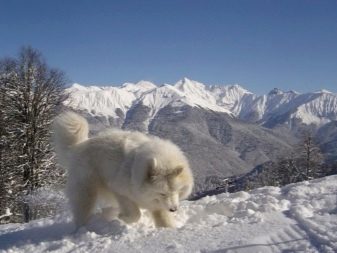
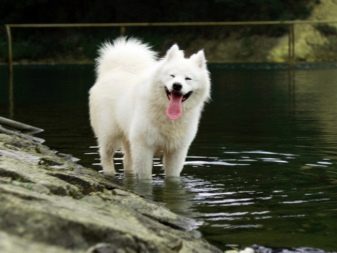
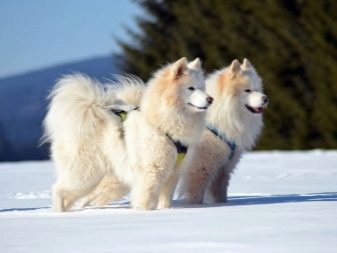
Pros and cons of the breed
Before acquiring a dog of this breed, you should carefully familiarize yourself with its features, advantages and disadvantages. Experienced owners of Samoyed huskies do not recommend starting such dogs, impressed exclusively by their spectacular exterior and good-natured disposition. Like any other animal, Samoyeds have their own specific pros and cons.
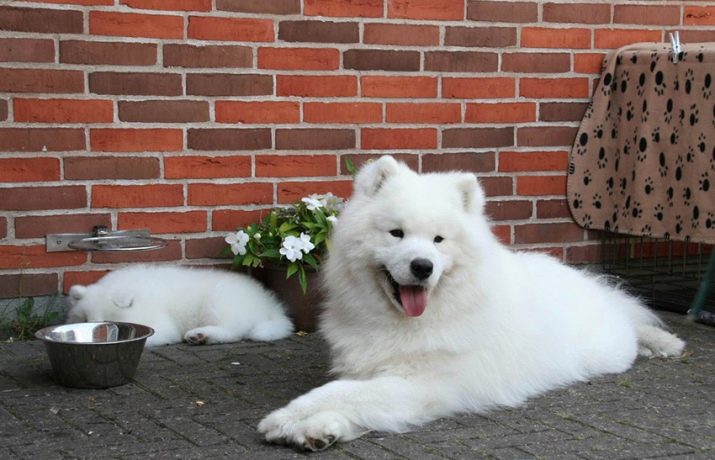
So, it is customary to attribute to the indisputable advantages of Samoyeds not only their luxurious appearance, but also:
- friendly character;
- friendly attitude to children;
- good health;
- endurance.
Breeders of dogs of this breed argue that Samoyeds, possessing increased mobility and energy, do not let their owners get bored. This aspect is important to consider for those people who prefer a calm and measured leisure.

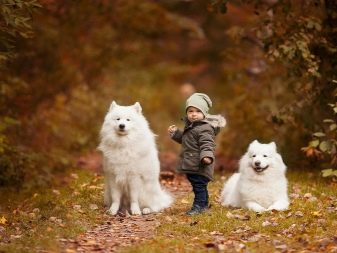
In this case, before buying a pet, you should carefully evaluate your capabilities and the amount of time that you plan to devote to the pet in the future.
The relative disadvantages of dogs of this breed, in turn, include:
- propensity to dominate;
- tendency to stubbornness, disobedience;
- tendency to vagrancy;
- intolerance of loneliness;
- the need for regular hair care.
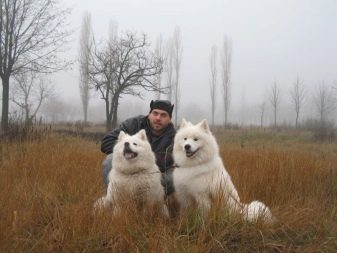
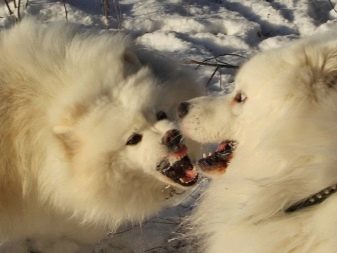
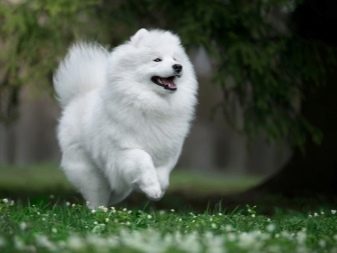
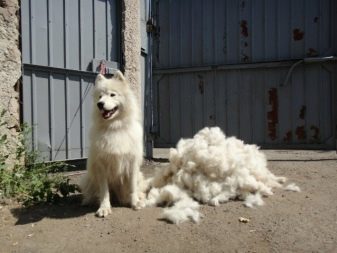
Left alone, the Samoyed is able to spoil things and furniture, thereby expressing homesickness. As a companion dog, he needs the attention of his owner.
However, the contradictory nature of this animal is often manifested in attempts to dominate the host. Such behavior must be suppressed, and this, in turn, requires the owner of the dog the skills to properly handle animals.
Another specific nuance in the content of Samoyed is that this breed has poorly expressed protective qualities. Getting a Samoyed husky to protect the house, the owner of the animal usually does not get the desired result.
Also note that the Siberian origin of this breed determines the corresponding structure and specific features of dog hair. Samoyed huskies usually molt once a year, but this process takes up to 3 weeks. To make the dog look tidy during molting, the owner will have to devote enough time to combing the pet. A lot of trouble is caused by washing the Samoyed, and the subsequent drying of the wool. However, it should be noted here that the hair of these animals practically does not accumulate an unpleasant odor in itself - what is commonly called the "dog" in everyday life.
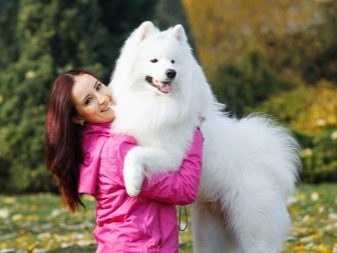
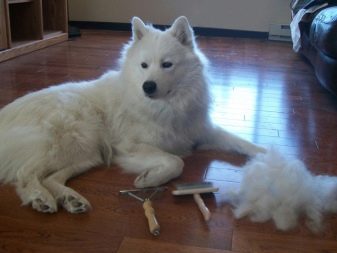
Varieties
Despite the fact that the history of the origin of this breed dates back more than 3 thousand years, professional cynological communities by historical standards became interested in it relatively recently. For this reason in each country their breed standards began to arise and improve, of which there are currently 7.
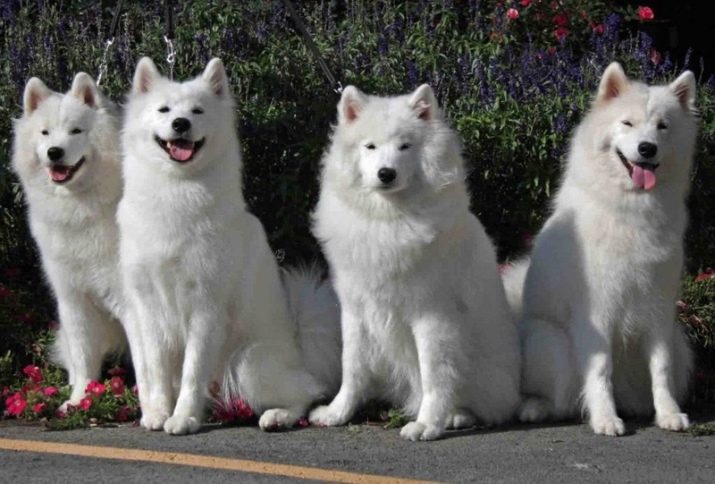
There is another classification of varieties of Samoyeds, proposed by the British zoologist Ernst Scott. Within the framework of this classification, dogs are divided into types based on the structural features of their skulls. In accordance with this classification, it is customary to distinguish the following types of Samoyed huskies:
- bearish;
- wolfish;
- foxes.
The representatives of the bear type are distinguished by a massive and powerful complexion, a large heavy head, a shortened and wide muzzle. The wolf type, in turn, is characterized by a thinner and leaner body, an elongated head and a slightly elongated muzzle. The fox type is characterized by a thin complexion, a narrow muzzle, slightly larger and slanting eyes (in contrast to the previous types).
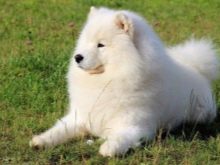
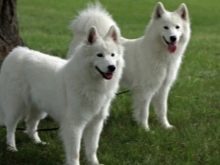
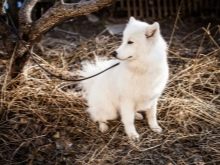
Character Features
Dogs of this breed have a very bright, playful, friendly, but controversial character. Some representatives of this breed often show willfulness and tend to gain a dominant position in the host-dog combination.
In the absence of proper upbringing and control on the part of the owner, an overly curious and playful Samoyed is able to escape while on a free walk. For this reason, experienced breeders recommend from the very first days of acquiring a puppy to devote a sufficient amount of time to the correct and proper education of the pet.
As practice shows, Samoyed huskies get along well with children, show increased attention to them and even try to take care. The potential of this breed in fact allows, with a competent approach, to raise a conscientious nanny, reliable friend and companion for children from a pet.
Samoyeds are hyperactive animals that need regular intense exercise. They treat strangers incredulously, but do not show aggression.
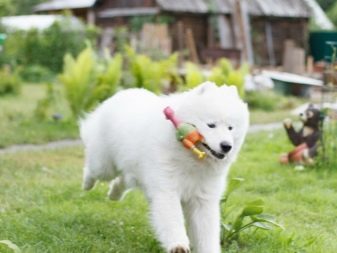
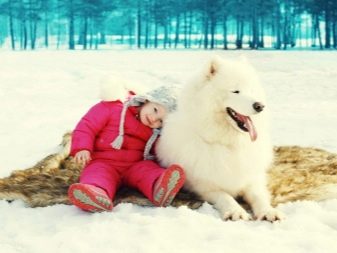
Experienced breeders argue that the non-malignant nature of these dogs allows them to easily get along with other animals.
How to choose?
When planning to have a Samoyed spitz, you should decide on the purpose of acquiring a pet. If the potential owner expects to buy a puppy for the purpose of further participation in exhibitions, special attention should be paid to the pedigree of the animal. In addition, even at the selection stage, it is important to exclude any possible defects that could subsequently cause a dog to be disqualified. An important role is played by the puppy's exhibition potential inherited from his parents. It is preferable that parents have successful experience in participating in exhibitions, possess appropriate awards and titles.
Professional breeders recommends that you carefully familiarize yourself with the breed standard before buying a puppy. If the dog is purchased not for exhibitions, but for the home and “for the soul,” minor deviations from the standard can be considered uncritical. A more important condition is the state of health of the baby, the lack of genetic or chronic diseases.
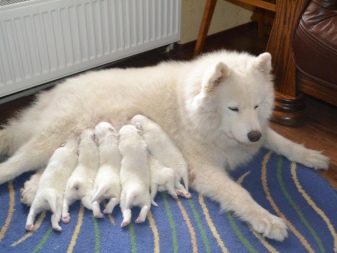
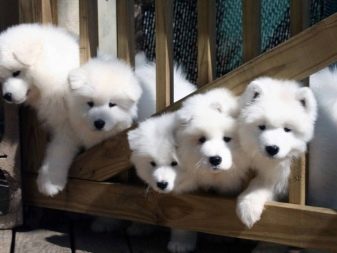
Given this condition, it is only necessary to apply for the purchase of a future pet to a reliable and conscientious seller (nursery or club), who has a good reputation with breeders and owners of Samoyeds.
Visually, the puppy should not look sick or weak. The coat should be clean and shiny. Scratches, bald spots, traces of activity of skin parasites should not be visible on the puppy's body. The color must comply with the breed standard.
The skin of healthy puppies is pinkish, clean, without spots, acne, growths and strange formations. Ears and eyes should be clean, without any signs of discharge.
The puppy should not emit an unpleasant odor, which often indicates infectious diseases or endocrine disorders. Also, the unpleasant odor emanating from the animal can indicate serious digestive problems, as well as diseases of the gastrointestinal tract.
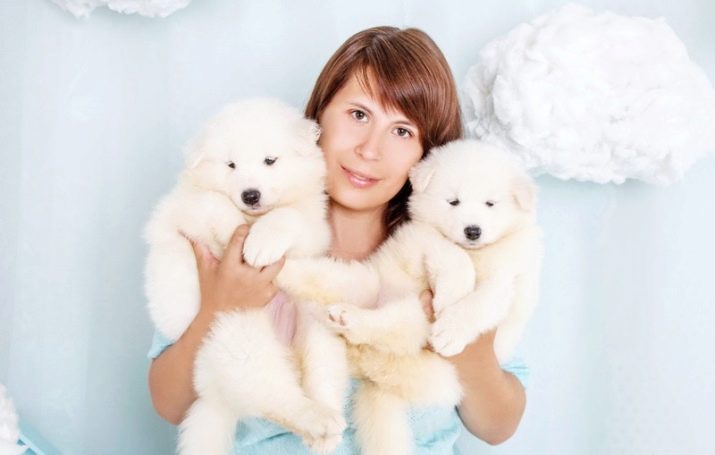
During the inspection, you need to feel the puppy. His stomach should be tight, but not swollen. A swollen belly in combination with a dull hair that has fallen off indicates that the animal is infected with helminths.
Healthy puppies are characterized by mobility, activity, curiosity. They willingly make contact, show interest in a stranger. Aggression or cowardice indicate an unstable psyche of the animal, therefore it is undesirable to acquire such puppies.
The gait of the puppy should be appreciated. When moving, the animal should not roll sideways or limp. Gait disorders often indicate joint problems or diseases of the musculoskeletal system.
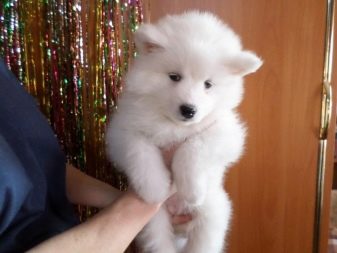
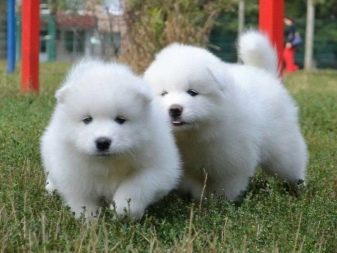
Both the hind and front legs of the puppy should be straight and symmetrical, the pads should be black, elastic. Dewclaws should be removed. The tail can be lowered if the animal is in a calm state. If the puppy is excited, his tail should be thrown onto his back and descend on one side.
When acquiring a puppy boy, you must carefully feel his scrotum. Both testes should be omitted. Cryptorchidism (undescended testes in the scrotum) is considered a serious defect.
Ears should be small, triangular. They get up in Samoyed puppies usually for 4-5 months of life.
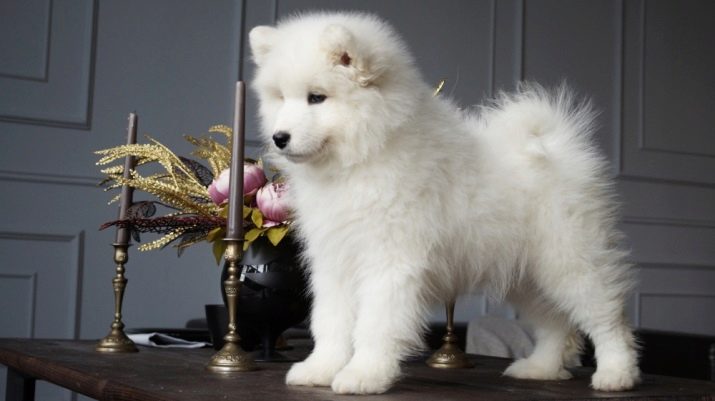
It is important to make sure that the puppy is accompanied by a package of necessary documents. It should include a special puppy card with all the data and the seal of the club (nursery), a veterinary passport, as well as the contract of sale of the animal.
How to name?
In choosing a suitable nickname for a Samoyed husky puppy, you can focus on both its external features and character. Here you can cite quite popular variants of names such as Sunny, Sammi (another name for Samoyeds), Whitey, Squirrel (Belek, Belyash), Snowball (Snowball, Snowflake), Suga (Sugar), Snowy, Snow. Other common names are Blanca (Bianca, Blanca), Alba (Albert, Albo), Salt, Marshmallow, Pearl, Ice, Frozen, Cloud, Angie (Angel), Crystal (Krista).
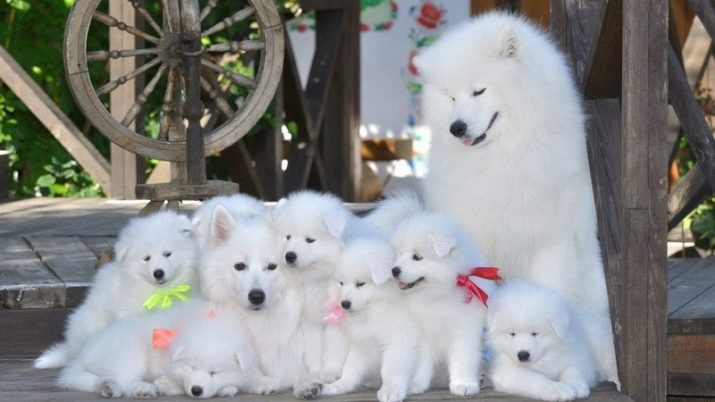
The Samoyed Spitz boy can be called Cosmos, Old, Prime, Grand, Bright, Titan, Atlant, Boeing. Playful and mischievous puppies are often given such nicknames: Tyson, Fight, Game, Play, Fly, Casper, Charlie, Dexter, Joy, Breevy.
Dogs of this breed are suitable for nicknames that are consonant with the names of ancient deities and mythical characters. Examples include the following options: Zeus, Hermes, Mars, Uranus, Hercules, Argo, Pegasus, Sphinx, Orpheus, Hephaestus, Theseus, Jason. Girls of the Samoyed breed are suitable for such names from the proposed topics: Nymph, Venus, Athena, Hera, Vesta, Diana, Shakti, Ariadne, Medea, Kallipso.
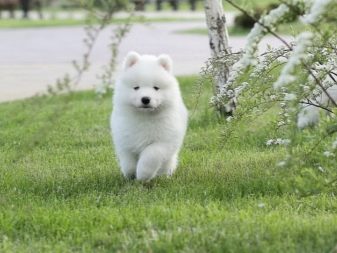
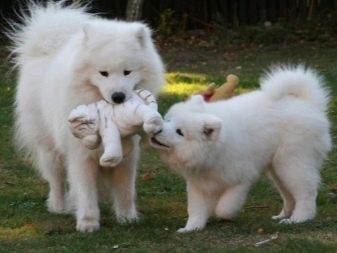
Very often Samoyed huskies are called beautiful and harmonious foreign names. The most popular options here are such nicknames for puppy boys: Charlie (Charles), Archie (Archibald), Arthur, Oscar, Tyler, Gordon, Jamie, Jake, Dexter, Ryan, Edward. For puppy girls, these names are often chosen: Gerda, Greta, Margot, Berta, Emma, Adele, Britney, Evie, Grace, Amelie, Alice, Rose, Darcy, Xena, Gisele, Chloe, Heidi, Aisha, Ivory, Yvette, Vega .
Very popular among dog breeders and nicknames associated with the world of secular fashion and the attributes of a glamorous life. Examples of such names as Versace, Prada, Tiffany, Gucci, Dior, Cartier, Cardin, Chanel, Dolce, Chloe, Birkin, Rolex, Bentley can be given here. Such nicknames also sound original: Snoopy, Bambi, Santhi, Pretti, Darcy.
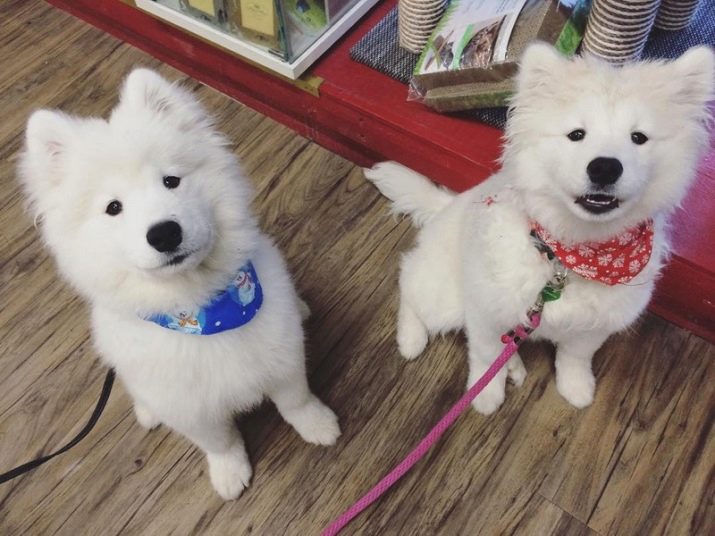
Content
It is preferable to keep a Samoyed husky in the aviary, but in no case on a chain. The animal will feel great also in the conditions of a private house with a small lawn and a closed yard for walking.
The content of Samoyeds in the apartment is also allowed. However, it is important to consider that these hyperactive and moving animals will need regular and long walks. Little puppies will initially not experience inconvenience when kept indoors, but over time, their need for movement and physical activity will begin to increase.
If the dog is supposed to be kept in an aviary, it is important to consider that this design must be strong. Mobile, physically powerful and strong Samoyeds are able not only to easily break an unstable door and tear a net, but also to dig and even jump over the high wall of the enclosure.
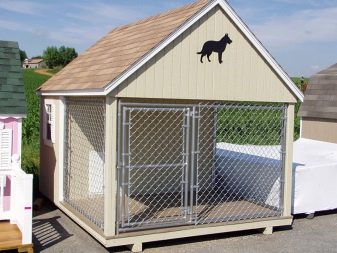
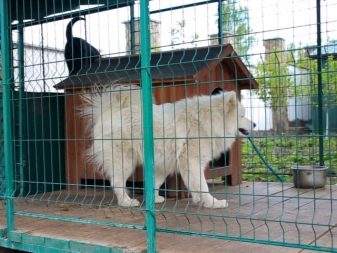
Thick and lush coat does not allow Samoyeds to freeze even in very cold weather. However, in the summer, these dogs should be protected from abundant sun and heat, which can cause heat stroke. In case of hot and sunny days, there should be a shelter in the aviary, in the shadow of which the dog can hide.
Food
Many Samoyed owners claim that these animals are not too pretentious about food. However, for the full development and physical activity, they need a balanced diet rich in vitamins and minerals.Specialized dry feeds from well-known manufacturing companies are able to provide this. Professional Samoyed breeders recommend products from Bosch, Belcando, and Diamond brands.
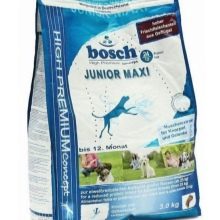

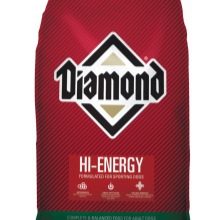
If the diet of the Samoyed is planned to be based on natural feed, the owner should consider what products and in what form should be offered to the pet. So, the list of allowed products recommended for everyday diet includes the following:
- beef, ground beef;
- chicken, turkey;
- offal (beef heart, lungs, chicken stomachs and chicken heart);
- oceanic and marine lean fish;
- buckwheat and rice porridge;
- dairy products (kefir, low-fat cottage cheese, fermented baked milk, varenets);
- goat milk and goat milk curd.

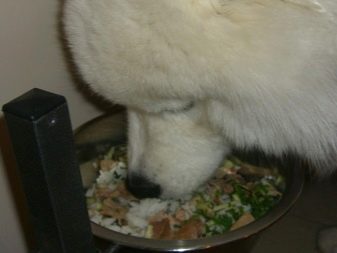
It is allowed to dilute the Samoyed diet with vegetables - cauliflower, Chinese and white cabbage, zucchini, cucumbers, sweet pepper. Some dogs of this breed are very fond of fruits, from which they can be given apples, bananas and pears. Vegetables and fruits are introduced into the diet of animals carefully, watching the reaction of the pet's body in order to avoid allergies or digestive problems.
Experienced dog breeders recall that a diet consisting of natural feed must be supplemented with vitamin-mineral complexes. Sweets, spices and spices, bones, fatty meats are categorically not allowed in the dog’s diet. It is also not allowed to give animals beets and potatoes.
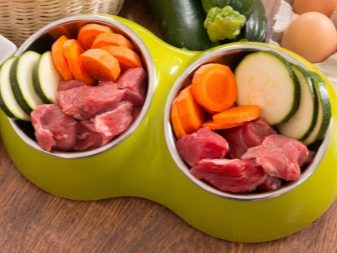

Feed your pet at the same time. The frequency and number of feeds depends on the age and individual characteristics of the dog (weight, build, daily activity).
Hygiene
Samoyed huskies do not require specific care, but their thick and lush coat needs constant combing and combing. These procedures are preferably carried out daily, preventing the formation of tangles.
During molting, the animals are combed out with a special wire brush. Such an instrument copes well with fallen hair and prevents it from falling into lumps.
Dogs of this breed do not need frequent washing. According to the breeders, it’s enough to bathe Samoyeds 1-2 times a year. To allow the animal to dry faster after bathing, it is allowed to use a hair dryer (provided that the dog is not afraid of it).
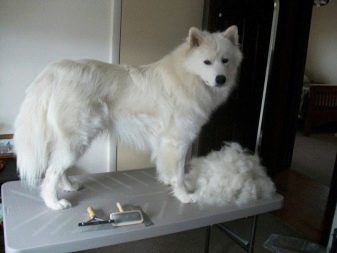

To make the Samoyed wool look perfect after bathing, it is recommended to use special zooshampoos with a brightening effect and conditioners. A zoo shampoo enhances the radiant whiteness of the coat, and conditioner makes combing easier.
Claw trimming is almost unnecessary if the dog walks a lot and often. During walks, Samoyed’s nails grind to the optimum length.
After walking, it is advisable to inspect the pet's paws every time. Given that these dogs are very active during walks and move a lot, often there is a risk of injuries to the paw pads. If wounds, abrasions or cuts are found on the pads, it is necessary to treat the damaged area with hydrogen peroxide, and then lubricate with fucorcin.
Samoyed paws should be washed after each walk. This simple hygienic procedure will help protect the dog's paws from exposure to harmful reagents in winter, and clean them of dust and dirt in summer.

In addition, washing the paws can significantly reduce the risk of contracting various diseases, the pathogens of which the pet can bring from a walk.
Many owners of huskies, trying to make life easier for pets in extreme heat, cut and even shave their wards. According to experienced dog breeders, Samoyed huskies should not be shaved. After this procedure, animals become even more susceptible to high temperatures, since the wool serves as a kind of thermal insulation for them. In addition, it was noted that shaving negatively affects the condition of the animal’s hair in the future: it grows more slowly, and its structure becomes much worse.
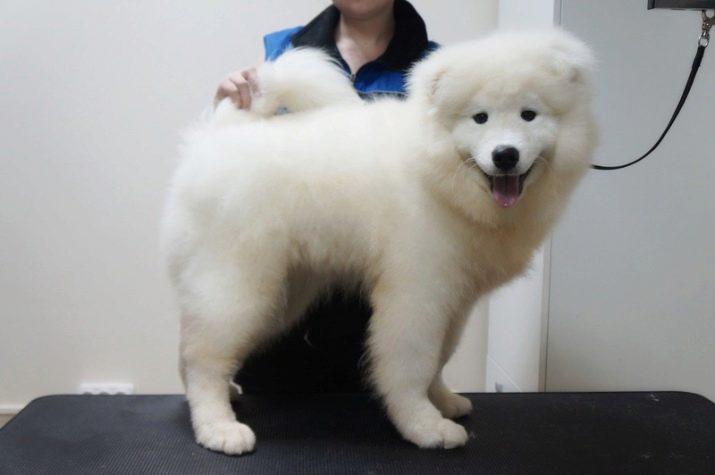
Training
Samoyeds are very trainable.This is facilitated by their natural ingenuity, curiosity and good memory. Even without the knowledge of a professional trainer, any persistent owner can train his pet a number of simple teams.
It is necessary to start training and raising an animal from puppyhood. An adult animal is much more difficult to teach the necessary teams. To a greater extent, the situation is exacerbated in cases where an adult dog is trying to take a dominant position or ignores the owner.
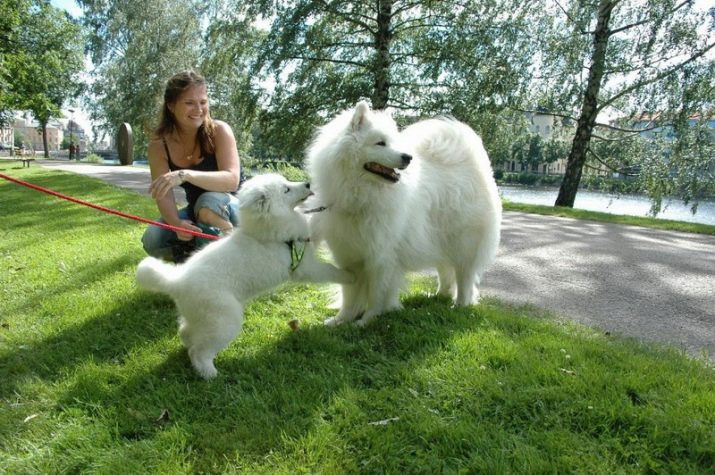
The list of basic commands that the owner of the Samoyed can teach the pet on his own includes such as “To me”, “Sit”, “Lie”, “Fu”. The correct implementation of the master's commands during training is recommended to encourage a treat. As a treat, professional breeders recommend using boiled chicken hearts, cut into small pieces, slices of hard cheese or slices of boiled beef liver, dried in the oven.
At the age of 3 months, a puppy of a Samoyed husky should be recorded on the general training course. Under the guidance of an experienced instructor, the dog will quickly learn to perform an extended list of special commands, including those that are given to the animal with gestures.
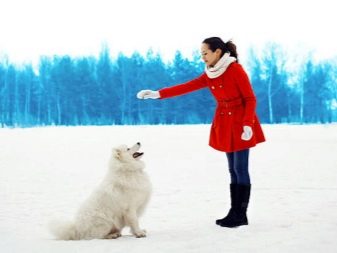
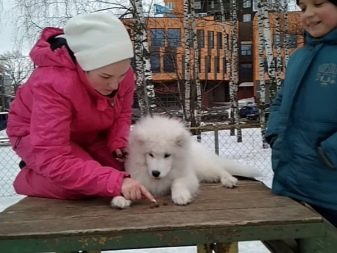
The training and training of Samoyed huskies should be combined with sports training. Dogs of this breed need intense physical exertion, which strengthen the muscles of the animal, develop endurance, have a favorable effect on the neuropsychic state.
When training a Samoyed husky on its own, it is necessary to adhere to general recommendations related to raising and training a dog. TSo, give commands should be calm, even, strict and confident voice. A cry is not allowed, threatening or, conversely, too gentle affection. Strong physical force should never be used.
If the animal is tired, the training must be interrupted. During breaks with the pet, you can play the ball or give the dog the opportunity to relax and gain strength.
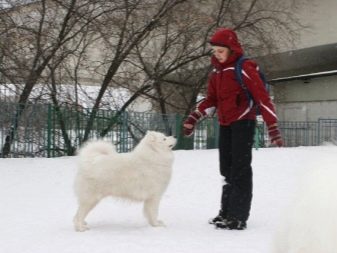
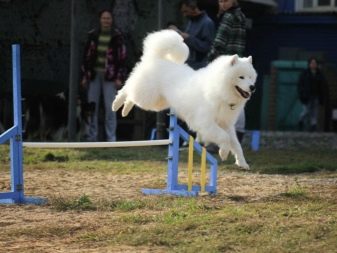
Training should be regular, but not exhausting. If they give the animal an uncomfortable sensation, the pet will be reluctant to carry out the commands, and over time may begin to avoid training.
Owner reviews
According to the reviews of the owners of dogs of this breed, Samoyeds are unusually charming, charismatic creatures with a bright character. Their unique features are quick wit, curiosity, good memory, and the ability to learn quickly. The non-malignant nature of Samoyed huskies allows them to easily get along with other pets, to find a common language with children and others.
However, the content of dogs of this breed has its own specific features. All those who dream of having a Samoyed should be aware that this dog is primarily a companion. Samoyeds tolerate loneliness very poorly, they need housekeeping attention and love. You will not have to get bored with such a dog, therefore, a sociable and friendly person leading an active lifestyle can become the best owner for a Samoyed.
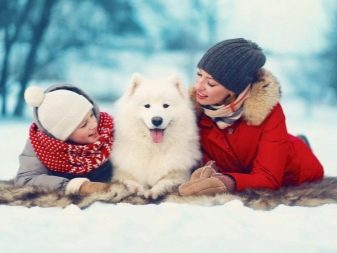
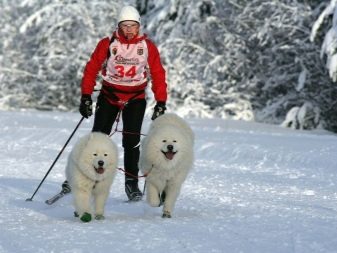
Despite the good natured character, many Samoyeds are great zealots. In the struggle for the attention of the owner, they may try to squeeze the rest of the family members.
When planning to buy a dog of this breed, it is important to take into account that its luxurious appearance is the result of competent and tireless care. The fluffy hair of the Samoyeds can stray into untidy tangles and lumps, causing the animal discomfort and discomfort. The future owner should be prepared for the fact that he will have to devote a lot of time to combing the wool. However, the results will invariably exceed all expectations.
It is difficult to imagine a more loyal and intelligent animal, able to compete with the Samoyed. This dog can brighten up any weekday, charge it positively, give a lot of joyful and positive emotions. A person who decides to become the owner of this unique breed will never regret his choice.
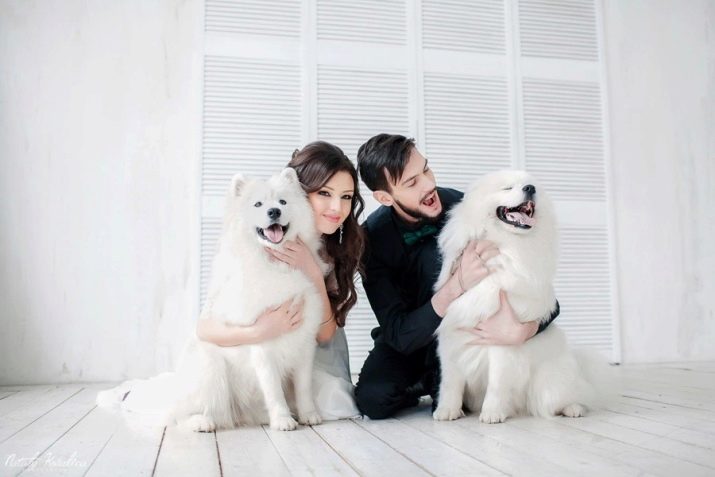
For information on keeping Samoyed at home, see the next video.
